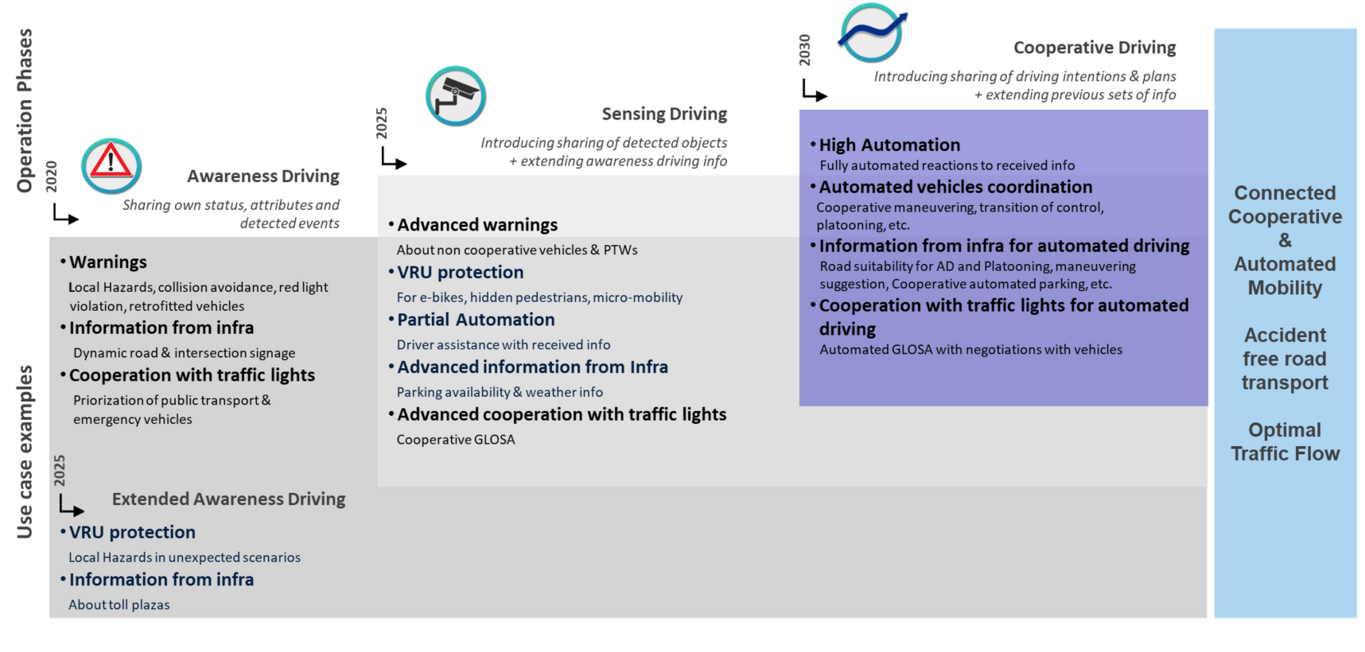Mission & Objectives
In the CAR 2 CAR Communication Consortium, leading European and international vehicles manufacturers, equipment suppliers, engineering companies, road operators and research institutions join forces for saving lives by research and development of C-ITS solutions facilitating to overcome road accidents (vision zero). This goes hand in hand with supporting highest safety level at improved traffic efficiency anywhere, anytime at lowest costs to the end user and the environment. Reaching the goal requires powerful, reliable, robust and mature safety related solutions. Furthermore, a seamless evolution path is required for enabling spectrum efficiency, needed functionalities and technologies driven by innovations and competition while safeguarding already taken investments in vehicles and road infrastructure.
The automotive solutions support all SAE driving levels from manual to fully automated considering the specific needs of different branches, stakeholders, users and related business models. Mitigation with existing other communication systems (e.g. tolling, urban rail) in neighbourhood of the ITS spectrum at 5.9 GHz is considered and granted. Avoiding accidents by fore-sighted cooperative driving is primarily a tactical issue requiring sharing of information, perception, awareness and intentions between the road users in their vicinity and with the road infrastructure.
For achieving its full potential interoperability of cooperative systems is required, e.g. spanning all vehicle classes across brands and borders as well as for cooperative road infrastructure systems which have to ensure seamless service quality for drivers and cooperative automated vehicles cross-border in Europe.
The Consortium is convinced that ad-hoc short-range cooperative V2X being part of cooperative Intelligent Transport Systems and Services (C-ITS) plays a major role in achieving these goals. Hence the CAR 2 CAR Communication Consortium is engaged in R&D, development, standardisation, testing, international harmonisation and supporting aligned deployment of holistic cooperative safety related systems and services in Europe. The developed cooperative V2X safety related functions make use of ad-hoc short-range V2X communications comprising e.g. V2V (vehicle-to-vehicle), I2V/V2I (vehicle-to-infrastructure) and P2V/V2P (vehicle-to-person).
The objective of the C2C-CC also extends to worldwide harmonisation and promotion of C-ITS as far as required enabling C-ITS to exploit its full potential. Therefore, the C2C-CC contributes to European and International standardisation and harmonisation activities for development of technical specifications, required for Cooperative Intelligent Transport System (C-ITS) including V2X communication.
The Consortium has been founded in 2002 by vehicle manufacturers with the objective of developing European standards for C-ITS, as prerequisite for interoperability of systems improving road safety and road efficiency. Moreover, the Consortium discussed realistic deployment strategies and maintains the developed phased deployment roadmap. Related business models are considered for speeding-up the cooperative V2X market penetration. In close collaboration with other international stakeholders, especially from the US and Japan, the Consortium pushes the harmonisation of cooperative V2X standards world-wide to save lives by avoiding as much accidents as possible striving towards accident free traffic (vision zero) everywhere at any time becoming reality at the earliest possible date.
Achievements
The CAR 2 CAR Communication Consortium steps forward in reaching its ultimate goal to save lives on the way to making the vision of accident free traffic happen as soon as possible. The Consortium contributes to support the highest safety level and to improve traffic efficiency anywhere at any time without permanent costs to the user. The C2C-CC fosters cooperative concepts based on sharing information, perception, awareness and intention between the road users and with the road infrastructure in their vicinity while focusing on the tactical scope of the cooperative vehicle and considering strategic and planning levels as required.
Since 2019 OEMs are deploying mass market vehicles with Day 1 services and standard cooperative ITS (C-ITS) based on the mature IEEE 802.11p (ETSI ITS G5, WLANp) ad-hoc communication technology. The Basic System Profile R 1.4 developed by members of the CAR 2 CAR Communication Consortium and harmonised with the complementing C-Roads specification for the road infrastructure, builds the baseline for interoperability and backwards compatibility benchmarks of all C-ITS implementations and future releases of the Basic System Profile. By closely collaborating with the infrastructure industry, road authorities, road operators, cities and regions, in the Amsterdam Group and C-ROADS across Europe, the Consortium fosters the cooperative ITS (C-ITS) development and supports its deployment. Seamless evolution of cooperative ITS (C-ITS) allows the safeguard of investments already taken while innovations and competition enable further developments of sophisticated cooperative systems and services for vehicles and road infrastructure supporting all road users, drivers as well as cooperative automation for reaching the ultimate goal of vision zero.

You want to know more? Contact us!

Niels Peter Skov Andersen
General Manager
npa@car-2-car.org

Steve Schneider
Administrator
contact@car-2-car.org


